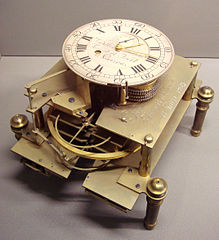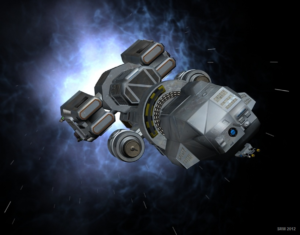This post originally appeared on the now-defunct Arcane Game Lore blog.

My last post on Void Sickness along with reading Mike Bourke’s second portal article (I’m still a week behind but I’m catching up!), got me thinking about another aspect of Void travel that I like to use but which I don’t see talked that much about: where you come out on the other end. And since I’m approaching it as something you can’t completely control, the exact location is somewhat unpredictable and can have unexpected results. So this will be another entry into the November RPG Blog Carnival. Enjoy.
Never the Same Place Twice
Last time I played with the Disruption parameter. This time I want to talk about Repeatability. When I was defining void travel in the previous post, I stated that the repeatability was “vague” which was defined as “A new Portal from the same origin may be directable to some point near where the old one was” in the original portal article that sparked my first post. In his second article, he added, “but the exact same destination is unreachable” to the end of that when he summarized the detailed definitions. In that second post I liked the definition he gave for “unpredictable” which was “A new Portal from the same origin will connect with another point completely at random, uncontrollably, within the destination plane of existence, perhaps restricted to a significant region.”
My idea of void travel falls somewhere between those two. It’s not that reaching the exact same location is impossible, it’s just very unlikely. You’ll always end up close (on a cosmic scale) unless you make a major mistake but probably not in the same location. And in truth the chances of actually starting in the same place are slim to none as well depending on your definitions of location and the scale of what constitutes the “same origin” (Are you measuring in meters, kilometers, or AU?). Given the two summarized definitions I’m actually leaning a little more toward unpredictable but both work. The point is, the place you come out is always going to be different. Let’s look at that and what it may mean for your game.
Non-repeatability
So why is it not possible to come out in the same spot? From my perspective this comes down to two factors that related to how I treat void travel. In my interpretation of how void travel works, whatever vector you have in the real universe when you enter the void is the vector you maintain in the void. You can’t change your direction and you move in a “straight” line. Which means you need to be lined up exactly right or you’re going to go way off course.
Stay on Target
Just how exactly do you need to be lined up? Let’s look at a couple of examples. Take a piece of paper. Draw a small dot on it no larger than half a millimeter. Now hold that up at arm’s length. See how big that dot is? Depending on the size of your dot and the length of your arm, that dot covers an angle of about 2-3 arc minutes. If your direction vector were off by that much, how far off would you be at your destination?
I’m going to be generous and assume you drew a small dot and have a long arm and go with the 2 arc minute number. Assuming you make a small void jump, say 4.3 light years, the distance to the nearest solar type star, Alpha Centauri, you’d be off target by only 5.5 billion kilometers. Space is big, that’s not too bad, right? Well, that’s about 36.7 Astronomical Units (the distance between the Earth and the Sun). Which means if you were shooting for Earth, you’d be out by Pluto. Depending on how fast your ship is, that may take a while to compensate for.
But an error of 2 arc minutes is pretty big. We can do better than that. Let’s say we can get our error down to the size of an arc second (1 degree = 60 arc minutes = 3600 arc seconds). That’s equivalent to putting your dot about 24 feet (7.2m) away. If we do that and make the same jump to Alpha Centauri, we’d still be off by about 46 million kilometers or 0.3 AU, roughly the distance between the Earth and Venus at closest approach. (By the way, an error of 1 arc second means your ship moved laterally 4.8 mm after traveling 1 kilometer). And if you make a jump twice as far, the error will be twice as large as it is really just the direction error (in radians) multiplied by the distance traveled. Double the distance, double the offset.
Just based on that, you can see that you’re probably not going to come out at the same place at your destination no matter how hard you try. Getting your vector to that accuracy is going to take some effort. But there is another effect, the time spent in the void.
How Good is Your Clock?

The other aspect of determining your position is how long you spend in the void and how far you travel in a given amount of time. If there are errors in your time keeping, this will translate into errors in the distance traveled.
Let’s use the example I gave in my earlier post: void travel occurs at the rate of one light year per second. Now, a light year is 9.4607×1012 km. That means that an error of a millisecond equal a distance of 9.4607×109 km (63 AU, roughly twice the distance to Neptune). A microsecond error reduced that by a factor of 1000 and an error of only a nanosecond reduces that by another factor of 1000 or down to an error of only 9460.7 km, less than the diameter of the Earth.
Modern computers can get to about a 10 nanosecond resolution which means an accuracy of about 95,000 km roughly 1/4 the distance to the moon. Depending on the technology you allow in your setting (and what you allow to work in the void), the accuracy could be better or worse than this. But even with a microsecond error, the distance you’ll be off is only 0.063 AU.
So while there is an effect, and you probably won’t end up in the same spot, it is much less than the effect you can expect from an error in the velocity vector. Depending on the story you’re trying to tell, that may or may not be negligible.
Impact on Your Game
We’ve seen what the scale of the effect is, what impact does that have on your game? While the details will depend on you exact setting, here are three ideas off the top of my head.
Travel times
Given the natural variation in arrival locations, you are typically going to be off target which means the actual travel time to the destination is going to vary. It will no longer be “three days” but “three to four days”. You can’t really plan on exact time tables.
To put some numbers to that, assume you were off by the 0.3AU distance from earlier. Assuming your ship is traveling at 1% the speed of light (3,000 km/s, just under 11 million km per hour), it will take you about 4.25 hours to cover that extra distance. If you’re off by more or going slower, it will take even longer (and that’s ignoring a bunch of real world physics about changing direction and such which will only add to the time).
This means that you have to plan for and account for the extra time and it may add tension to a situation. We only have 100 hours to reach the destination and stop the “big event”. The jump and associated travel time takes 80+2d10 hours to just get to the location where the big event will happen. Do the characters arrive with hours to spare or are they landing with only minutes until they have to spring into action? What impacts will this have on their preparations? Will it limit what they can do or bring to bear in the situation?
Space Piracy
Again ignoring real world physics of matching velocities in space, the result of non-repeatability of void jumps means you’re probably not going to have space pirates lurking in the outer system for ships to appear and then pounce on them. Even if you had hundreds of ships entering a system every day, the odds of one appearing near where a pirate vessel was lurking is really, really small. The pirate ship could sit out there for years and never have an encounter. This means that piracy, if it occurs, will happen near the population centers, at remote, fixed outposts, or on the outbound leg of a journey before the void jump when the routes are much more predictable.
Arriving in Formation
Remember this scene from Return of the Jedi? (0:43-1:04 is the relevant part if you don’t want to watch the whole thing).
That just isn’t going to happen with void jumping. Even assuming that you can get the velocity vector the same for all the ships, which might be hard but could be possible (although not with everyone dodging in and out among each other like the fighters in the beginning of that clip) the timing variations between the ship computers will scatter everyone across tens of thousands of kilometers of space. You will need time to regroup. Which means you probably want to appear further out in the system to allow yourself that time which in turns means longer travel to your destination and a greater chance for discovery.
Or if you do allow for piracy to occur in the outer reaches of the system, merchants and their escorts may be separated on arrival. The convoy scattered across space. Can the escorts get back to their charges before the pirates attack or do they only arrive in time to extract revenge for damage done?
Void Travel is Unpredictable
From the above thoughts, it’s fairly obvious that this method of FTL travel has the potential to add some randomness and unpredictability into your game. Whether to add tension or just flavor, there is no real reason that void travel should be routine. Are there other ideas for impacts that come to mind because of the unpredictability? Let us know in the comments below.
Comments
Mike Bourke – November 24, 2015 at 11:28 am
There’s an obvious solution: the very short void jump. You arrive and find yourself 30 AU away from where you want to be? Jump for long enough to travel 29 AU. This distance is short enough that the final error will be relatively small.
Now, I happen to think that this tactic, while eminently sensible, is not as desirable as the additional flavor that the randomness gives. That leads me to suggesting that in order to make a jump, a ship has to utilize a minimum amount of power or more, which in turn means that there is a minimum jump distance.
This wouldn’t completely eliminate the viability of the tactic; it would mean that the most practical approach is to aim for a point half your anticipated error away from whatever the minimum jump distance is. For convenience, let’s say that your maximum error is 10AU per light year, and you are jumping 20 light-years, and that the minimum jump is 150 AU:
10 AU x 20 light years is 200 AU maximum error. Half that is 100 AU, so that’s the mean error that you will experience. But that leaves you too close to make the minimum jump, so you move that destination point out by the minimum, and aim to arrive 250 AU away. That means that your range of arrival points is 250±100 AU – so even if you get as close to your ultimate destination as possible, you are still a minimum jump away, and might be as much as 350AU.
The thing is that picking just any point that far away is not good enough; you would need some standard navigational reference points from which to get your precise distance for the second jump. Observations would take time, and without standard references, you might have to wait for weeks, months, or years for the objects you are measuring (presumably outer planets) to have moved enough to permit navigation.
And standard reference points for a jump means that your arrival point is a much smaller volume of space – making piracy possible after all. Not easy, but not entirely out of the question, either.
Mike Bourke – November 24, 2015 at 6:58 pm
Alternately, maybe a ship develops some sort of energy “charge” that simply delays making another jump for a period of time. That would prevent the “stop short and recalibrate” dodge – if there’s a deadline involved.
Tom – November 24, 2015 at 9:26 pm
Yes, both of those are possible implications as well. I like the minimum power required idea. I didn’t include it here but I also utilize limit on gravity wells. Kind of like Larry Niven’s hyperspace. You can’t get too close to a large mass and still have your void jump system work. This actually counter acts some of the implications depending on how you implement it. I think that will be another void jumping article at some point.


